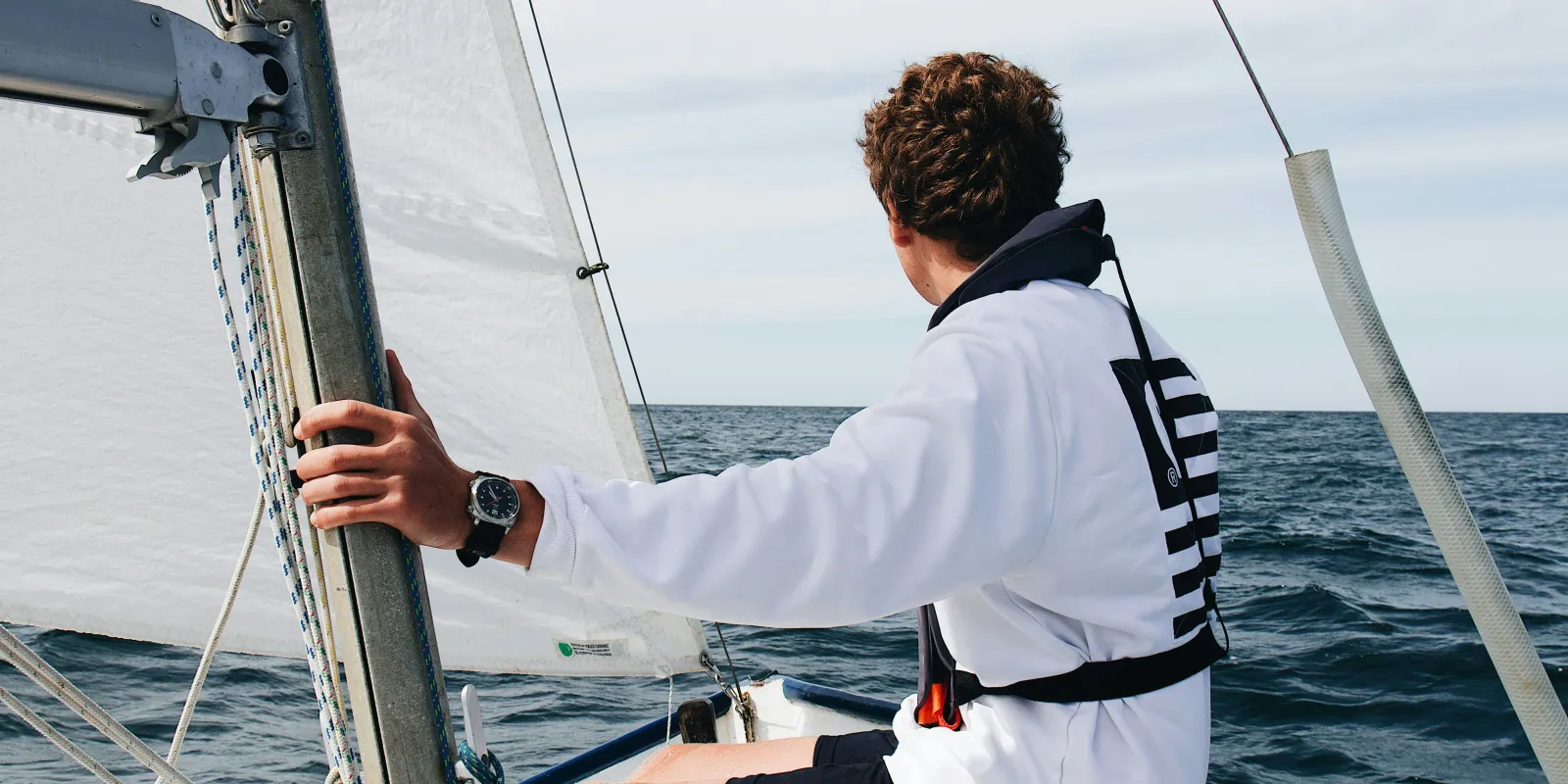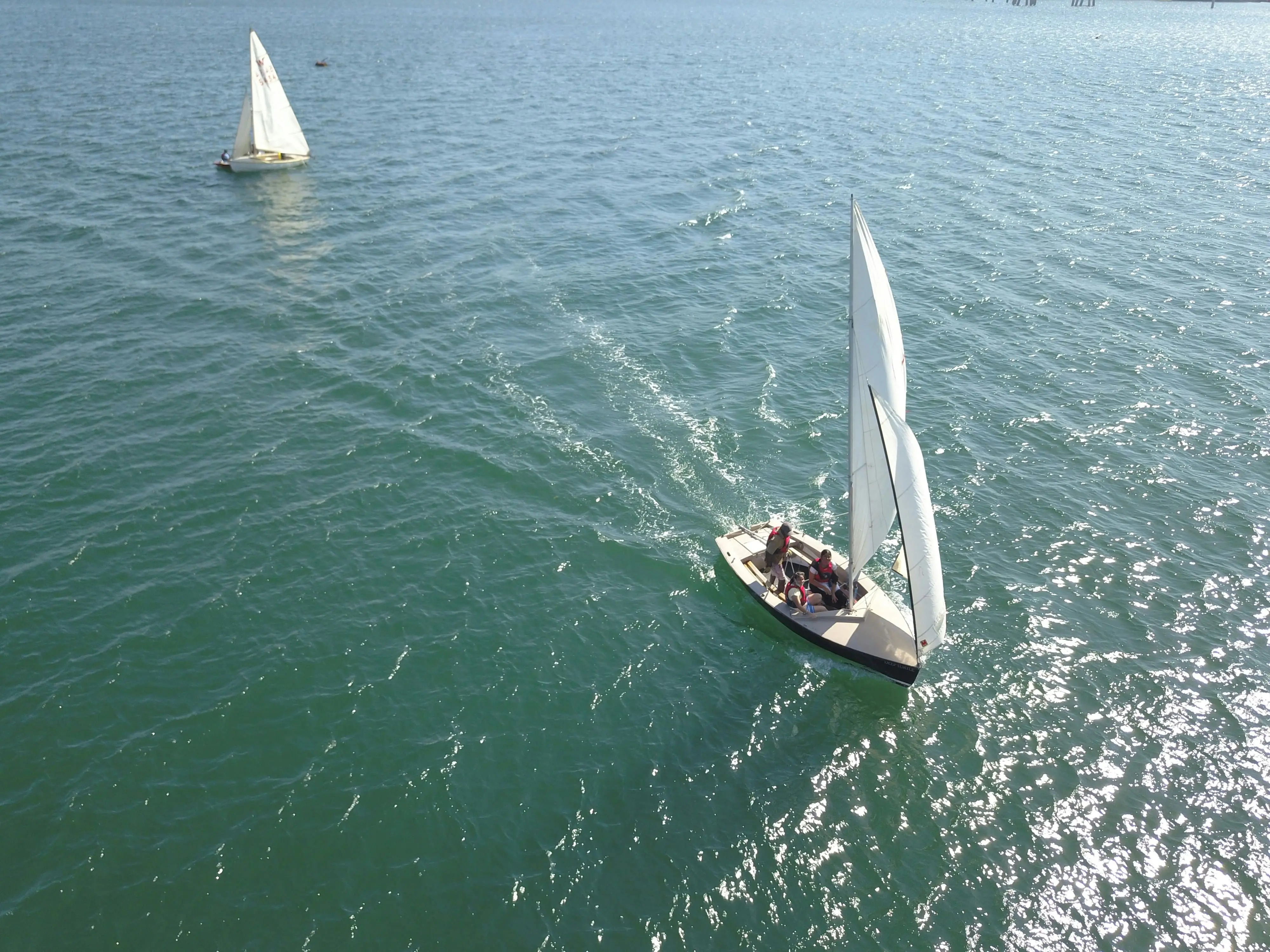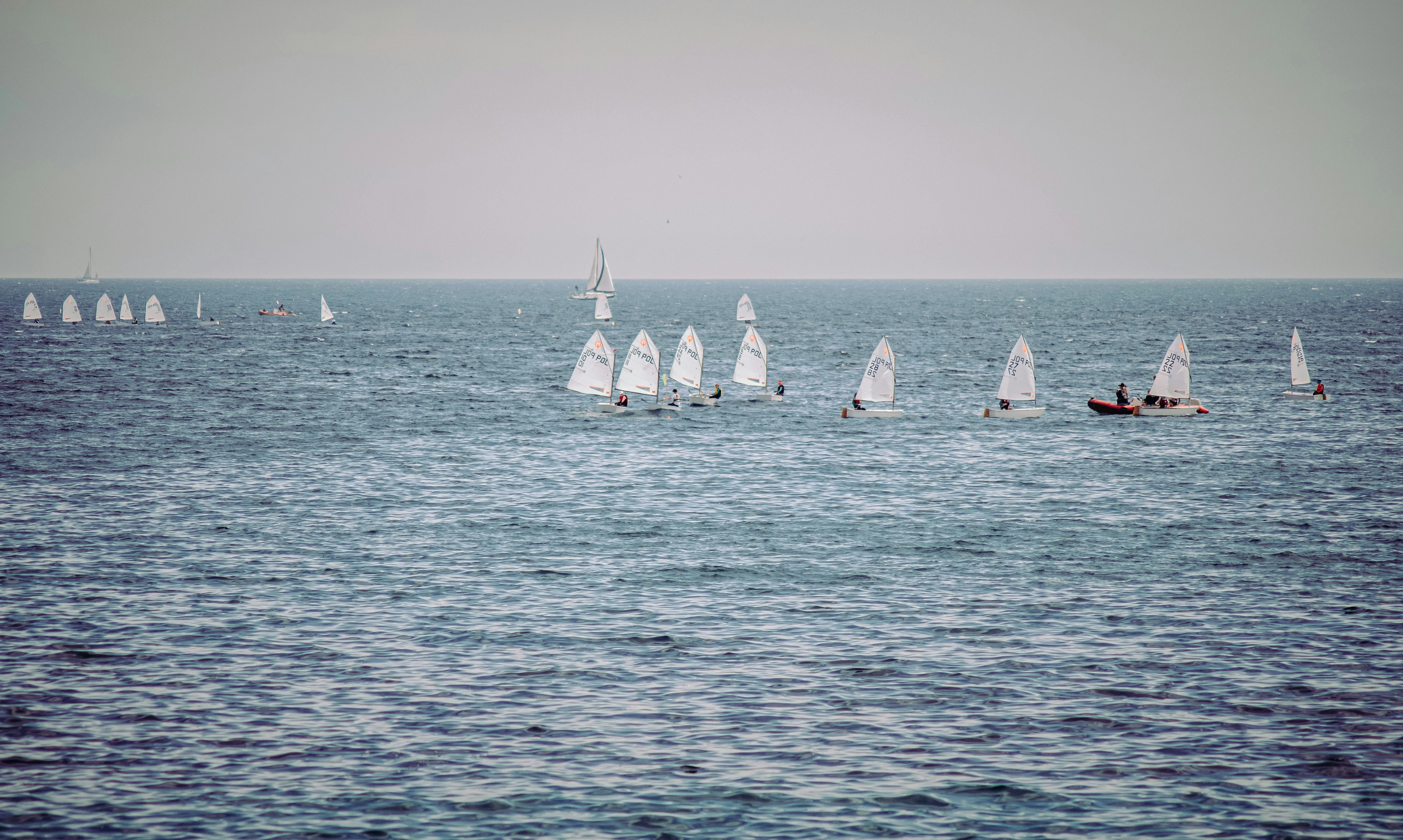
If you have ever dreamed of gliding across open water, living the wind and sea power and experiencing the thrill of setting the sails, you are in the right place. Sailboating for beginners may seem intimidating at first for some people but with the right knowledge and preparation, it is an exciting and rewarding adventure.
This guide covers the basics of sailing, essential terminology, beginner skills and expert tips to help you get started. Whether you are planning a one-time sailing trip or hoping to make it a lifelong hobby, these beginner-friendly insights will prepare you for a smooth, enjoyable first experience at sea.
Why Learn to Sail? The Magic of Sailboating
Sailing is not just a way of travelling— it is the trigger of a mindful journey that connects you with mother nature, builds spiritual growth, strengthens resilience and makes you truly free and fulfilled. For many, it becomes more than just a hobby: it is a lifestyle and a path of spiritual awareness, both as an individual and part of the universe.

Here is why so many people are drawn to the world of sailing:
A Deep Connection with Nature
When you sail, your soul rises by reminding you to be part of the natural world in a way that feels serene and full of euphoria. You will develop skills at reading wind patterns and waves angles, tides, cloud formations and sea life — learning to follow the signs and sounds of nature being one with it and grateful rather than compromising with nature as most people do today.
A Social and Cultural Experience
Sailing naturally brings people together. Whether you are joining a flotilla, crewing in a regatta or simply enjoying a sailing getaway, life on a sailboat is about closeness and sharing moments. You will meet fellow sailors from around the world, swap stories in the harbor and create lasting memories on the water. Sailing communities tend to be welcoming and passionate, making it easy to form new friendships that span oceans and continents. And if you are setting sails with your family or friends, sailing can also serve as a relationship quick trial. The confined space, teamwork and unpredictable nature of life at sea have a way of revealing dynamics and strengthening bonds or testing them in ways few other experiences can.
A Rewarding Personal Challenge
Sailing invites you to master new skills, navigate unexpected challenges and stay alert to ever-changing conditions. It is an activity that keeps your mind engaged and your senses sharp. Every time you set sail, there is something new to learn — whether refining a knot, trimming (= adjusting) a sail or performing routine yacht maintenance like yacht cleaning and basic technical repairs.
One of sailing’s beautiful truths is that it is not all about physical strength — it is mainly about technique and perception. The real art of sailing lies in understanding the weather and mainly the wind and waves along with boat performance. With the right knowledge, perception and intuition, yachts can be managed gracefully and efficiently. Therefore, sailboating is a complete lifelong activity accessible to people of all ages.
The Freedom to Explore New Horizons
A sailboat can take you to places where roads and land tours never could. From hidden coves and secluded beaches to remote island harbors and charming coastal villages, sailing offers a front-row seat to some of the world’s most beautiful, unspoiled places. The ability to drop anchor in a peaceful bay or chart your own course across open water is an unparalleled form of freedom. Each voyage becomes a personal challenge, a voyage of discovery where every day holds something new and unpredictable.
A Healthy Escape of Mindfulness
In our fast-paced, screen-driven world, sailing offers a much-needed escape for your inner peace. It is your chance to disconnect from devices and the material world and reconnect with nature recalling the harmony, simplicity of life and appreciating the value of little things in everyday life that often are taken for granted. Sailboating develops mental clarity, spiritual strengthening, physical well-being and a deep sense of presence. The constant interaction with the natural environment fosters a rewarding mindfulness that lingers long after you have stepped back on shore and learns to love yourself and be kind to people around you. Responsibility, confidence, discipline and respect are some of the characteristics developed in your character through this sailing journey.
Essential Sailboat Terminology for Beginners
Before you step aboard a sailboat, it helps to familiarize yourself with some basic nautical terminology. This makes it easier to follow instructions and understand what is happening on board.

Here are some important beginner terms:
- Port: The left side of the boat when looking at the front part of it.
- Starboard: The right side of the boat when looking forward at the back part of it.
- Bow: The front of the boat.
- Stern: The back of the boat.
- Mast: The vertical pole that supports the sails through rigging, ropes and other components.
- Boom: The horizontal pole attached to the mast, which holds the bottom of the mainsail and improves the angle of the mainsail.
- Rudder: A flat piece at the stern used for steering through handling the wheel or tiller.
- Tiller or Wheel: Controls the rudder.
- Main Sail: The large sail attached to the mast and boom.
- Jib: The sail at the front of the boat.
- Sheet: A rope or line used to control the sails.
- Tack: A sailing manoeuvre for turning 180° the bow of the boat through the wind.
- Gybe (or Jibe): A sailing manoeuvre for turning 180° the stern of the boat through the wind.
- Windward (or Upwind): The direction from which the wind is coming.
- Leeward (or Downwind): The direction the wind is blowing away.
- Cockpit: The open, central area of the boat where the helm (steering position) is located and where crew and guests often gather during sailing.
- Chart Table: A small onboard desk or table, usually located inside the cabin, used for navigation, holding maps, instruments and logbooks.
Learning these terms is a great first step toward feeling comfortable onboard. However, no worries if you do not have them all memorized just yet — practice is key and these terms will naturally come to mind at the right moments as you gain experience on the water.
Basic Sailing Skills Every Beginner Should Know
Once you have stepped aboard, it is time to get hands-on. These essential skills ensure your first sailing experience to be both safe and enjoyable:

1. Understanding the Wind
Knowing how to read the wind and adjust your sails is crucial. You will need to stay aware of wind force, direction and wave angle — and how your boat responds to them.
Tip: Sailboats cannot sail directly into the wind but can sail at angles to it using a technique called tacking.
2. Raising and Lowering the Sails
Learn to hoist the mainsail and jib, secure them with halyards and trim (= adjust) them to catch the wind effectively.
3. Steering and Changing Direction
Use the tiller or wheel to steer the boat and practice manoeuvres like tacking and gybing to change course based on the wind’s direction and your destination.
4. Reading the Weather Conditions
Spotting hints like, sky signs, gusts and waves helps you anticipate how your boat will move and which adjustments are needed.
5. Basic Knots
Master a few indispensable knots — like the bowline, clove hitch and cleat hitch and— for safety and efficiency on board.
Tips for a Smooth First Sailing Experience
1. Start with a Lesson or Join a Crew
If you have never sailed before, consider a beginner’s sailing course or joining a day cruise to familiarize yourself. Many sailing companies offer introductory lessons or opportunities for novices to sail alongside experienced crews.
2. Dress Appropriately for All Weather
Conditions can shift quickly at sea. Wear comfortable, waterproof clothing, a lightweight windbreaker with hood and non-slip shoes. Do not forget sunglasses (with a strap), a jockey hat and high-SPF sunscreen.
In addition to clothing, it is a good idea to bring along a few personal essentials:
- Sailing gloves: These protect your hands from rope burns and blisters when handling lines.
- A small flashlight or headlamp: Even on a day sail, it is handy if you end up docking later than planned or need to check something below deck or at night.
- A personal first aid kit: While the boat should have one on board, carrying a small personal kit is a good idea.
- A pocketknife or multi-tool: Many sailors carry one for quickly cutting a line or handling minor repairs.
3. Stay Calm and Listen to Instructions
The water might get choppy or a sudden gust might heel the boat. The best response? Stay calm, listen to your skipper and always follow the instructions with readiness.
4. Pay Attention to Safety Briefings
Pre-departure safety briefings might seem routine but knowing the safety equipment and protocols are very important for being on board.
5. Move Carefully and Hold On
Sailboats are at sea and therefore, tilt, shift and lurch. Always move with care and stability, keeping one hand free for yourself and holding the other one on the boat.
6. Stay Hydrated and Bring Snacks
It is surprisingly easy to get dehydrated at sea, especially under the sun and wind. To help your body handle the motion of the boat comfortably and to keep your energy up throughout the trip:
- Have a conservative breakfast consisting of light, dry foods like toast, plain crackers or cereal.
- Eat small food portions and avoid overeating before departure or food with high acidity as can lead to seasickness.
- Keep hydrated by sipping water regularly, combined with small amounts of dry food. An empty stomach can increase discomfort at sea, so it is best to avoid sailing on an empty stomach.
7. Swimming knowledge
It is important to know how to swim before joining a sailing trip. While life jackets are always available and safety measures are in place, basic swimming ability is a necessary personal safety skill when spending time at sea. Whether it is for peace of mind in case of an unexpected situation or simply to enjoy a refreshing swim in a quiet cove, being comfortable in the water adds to both your safety and overall experience. If you are not a confident swimmer, it is a good idea to take a few basic swimming lessons before setting sail — it is a small step that makes a big difference out on the water.
Bonus Tip: Ask a Local for Advice
One of the timeless wisdoms of sailing is swapping stories and advice with local fishermen. In unfamiliar areas, a quick chat with them can reveal priceless information about hidden rocks, tricky currents, sudden weather shifts and the best coves for shelter.
There is an old saying among sailors: “No chart or forecast can match the knowledge of a fisherman who is worked these waters for years.”
And in Greece especially, this advice is pure gold. A wave to a boat hauling in nets or a friendly greeting at a tiny harbor might earn you the kind of local wisdom you cannot buy — the spot where the wind drops at sunset or the little-known bay that is always calm when the wind blows.
To plan your trip wisely, it is worth checking the Best Time to Sail in Greece for ideal weather and sea conditions.
Common Mistakes New Sailors Should Avoid
Everyone makes mistakes when learning a new skill but knowing what to watch out for can help you to avoid the most common errors:
- Underestimating Weather Conditions: Even a gentle breeze can pick up suddenly. Always check the forecast and learn to recognize weather changes. Always keep track of where the wind is coming from — it affects every decision you will make on a sailboat.
- Oversteering: Small and gentle adjustments to the tiller or wheel are enough. Avoid sudden or exaggerated movements, which can cause loss of yacht control.
- Neglecting the Boom (and Your Own Safety): As mentioned earlier, always be mindful of the boom’s movement — it can swing across the deck suddenly when the boat changes direction. In addition to keeping an eye on the boom, always watch your hands and legs when moving around or handling lines. If you are unsure what to do in a moment of action, better to step back, stay clear and avoid risking injury rather than acting hastily.
- Poor Communication: Sailing relies on clear, simple and timely communication between crew members. Do not hesitate to ask questions or confirm instructions if something is not clear. Additionally, using hand signals or gestures when the wind or sea noise makes it hard to hear each other. Visual signals are an essential part of safe and efficient teamwork on board, especially when shouting is not an option.
Next Steps: How to Improve Your Sailing Skills
Once you have had a first contact with sailing, you might be eager to advance your skills and take on bigger adventures. Here is how to keep growing as a sailor:
1. Take an Accredited Sailing Course
Look for certified sailing schools or yacht clubs offering beginner and intermediate classes. These courses cover from boat handling to navigation and safety procedures.
2. Crew on More Boats
Joining crews on different types of sailing boats (keelboats, monohulls, catamarans) will broaden your experience and help you learn from a variety of skippers and sailing styles.

3. Practice Regularly
The more time you spend on the water, the more natural sailing becomes. Join sailing regattas and offshore sailing races, day cruises or a sailing club to gain experience of managing sails and the boat in different weather conditions.
4. Learn Navigation and Weather Forecasting
Understanding nautical charts, tides, currents and weather patterns is essential for longer trips or independent sailing. Many sailing schools offer dedicated courses on these topics but joining a crew either for a sailing race or a yacht charter with guests is where you can get the most valuable experience.
5. Study Sailing Theory
Books, videos and online forums are excellent resources to deepen your knowledge about sail trim, boat maintenance and sailing strategies.
6. Consider Chartering a Boat
Once you feel confident handling a sailboat, you might consider chartering one for a day or weekend with fellows so you can get the chance to improve yourself by taking the situation in hand. Many charter companies offer skippered or bareboat (with no crew) options, depending on your skill level.
Final Thoughts
Sailboating is one of those rare hobbies that combine adventure, relaxation and lifelong learning. For beginners, it might feel overwhelming at first — but every sailor starts somewhere and even the most experienced captains were once novices.
The key is to approach your first experiences with curiosity, humility and a sense of fun. Listen to your instructors, respect the sea and enjoy the moments when the wind fills your sails and the world quiets to just the sounds of nature, being you in it.
If you are dreaming of your first sailing adventure, whether as a beginner or simply looking to enjoy a carefree day on the water, Sunfos Alessia Yachting offers a range of tailor-made and group cruises by sailing yacht in Mykonos and the Cyclades. Led by experienced and friendly crew, these trips are perfect for those wanting to experience the magic of sailing in a relaxed, welcoming environment. It is a wonderful opportunity to learn the ropes, soak in the sun and discover the raw beauty of the Greek islands from a unique perspective that only the sailing yacht can offer.
Your sailing journey starts here — and there is no better place to begin than under the Aegean sun.



